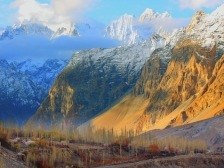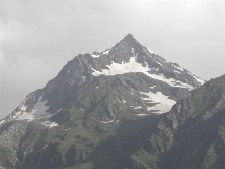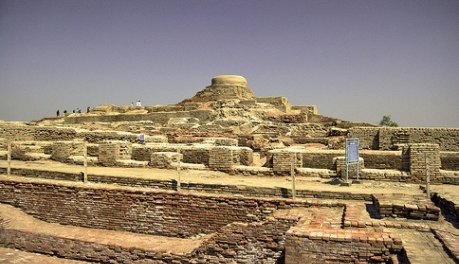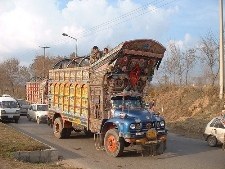Soumya Saxena
I recently visited a passport agent’s office in India. This agent also ran a travel agency from the same office and had tourism posters of various countries and other states in India pasted on its walls. I was browsing through these posters when one poster took me by surprise. It showed a highly decorated public bus in bright colors and below it was written:
The land of various colours: Pakistan

The photo above shows typical decorative art done on a Pakistani truck.
For a moment I quite really didn’t understand what I saw. This is because it was something I had never seen before. My utter surprise was not to end here as I saw another poster with an image of Gautam Buddha (in Gandhara art form) and again written below the image were the words:
The land of various colours: Pakistan
Gautam Buddha and Pakistan? For a moment I was in a fix again, and then I realized that Takshashila (Taxila) is part of Pakistan.
I certainly owe to my ignorance and also to the image of Pakistan promoted across the world, especially in India that I was unaware of the phrase ‘Pakistani tourism’. Actually I have never ever seen a tourism poster of Pakistan or for that matter anything to do with Pakistan which reflects its social or cultural life because unfortunately it is mostly about Kashmir or Terrorism.
Amidst all this we often forget that Pakistan is really in fact the land of colours. I went home and googled about the Pakistani Tourism and found this official tourism site (http://www.tourism.gov.pk/). Browsing through this site was not less than a revelation for me. I had never seen such an image of Pakistan, so many places to visit, historical remains, art, culture, fair, festivals, suddenly a more soft and pleasing Pakistan was in front of my eyes.




Later on I was discussing this topic with my Pakistani friend and he told me that the government does not do much to promote Pakistani tourism either abroad or at home. The historical and archaeological sites are mostly left to decay and defacement.
Zahida Hina, a known Urdu columnist, writes a weekly column ‘Pakistan Diary’ . This column appears in a sunday magazine called Rasrang . Rasrang is part of a Hindi language newspaper Dainik Bhaskar. In one of her articles she wrote that rains often flood the historical remains at Mohenjodaro, but no heed is taken by the authorities. I really felt sad after reading this, given the fact I have been a student of history and always wanted to visit the sites of the great Indus Valley Civilization.

I realize that in India and Pakistan, historical monuments are not preserved the way they should be. This even include the monuments which are labeled as ‘World Heritage’. Often it can be seen that visitors come and carve their names and other symbols on these monuments with stone, chalk, pencils, etc.
Treatment of tourists is another concern. The recent violent incidents in Pakistan creates a certain amount of hesitation and fear in the minds of the people whether to visit or not to visit.
However, people who have visited Pakistan have a lot to tell about the hospitality of the local people, the food, the culture, the lively ambiance of the country. All in all they give talk about an experience which is completely different from what they had perceived before visiting Pakistan.
Personally from what I have read and researched about Pakistan, I feel even a year is not enough to see the whole country. It is certainly blessed with natural beauty as well as historical and cultural diversity. Tourism industry can be very lucrative in Pakistan.


I want to end my post with a message that lets give tourism a chance. It may bridge the gap between people much quicker than any official/bureaucratic attempt to do so.
Author is a lawyer by profession and works for World Wide Fund in New Delhi
Photo Credits: Kamran Channa, Omer Aslam, Zahoor Ahmed, Saima, digital deadhead, Agha Waseem



















































@soumya saxena
For context, and to digress a bit, the whole narcissism issue popped up because of a poster (how ironic in context of the blog title) named Anand Srinivasan, I guess was not ‘happy’ at term “Pakistani art”. His baseless claim will remain senseless.
Now lets start our conversation with an agreement, Pakistan was once Hindustan (Persian in roots, an anomaly itself). This is true. Muslim rulers named it such. The Great Allama Iqbal referred to the same in his writings. As for Jinnah, while I am sure he referred to the term Hindustani but may have never called himself as Hindustani. His choice word would have be an “Indian”. You see, Jinnah was a lawyer and was always precise in his legal references. He would not make a mistake. But this is my best guess. There is chance I may be wrong.
But now let me see if I can an agreement from you.
The same stretch of historical context makes Pakistan, Hindustan, also makes Hindustan very much Indus (we are not sure what the good folks of Indus Valley Civilization called themselves, as their writings remain a mystery).
So, the mother of civilization in South Asia was centered around Indus in old name but what is now know as Pakistan as a modern name. If you want to visit Indus, you have to fly to Pakistan.
So, now lets try to keep these names in context.
Pakistan is what was Indus. India is what was generally known as Hindustan. Hindustan inherited from Indus. Therefore, India is really Pakistan. Q.E.D.
And thus, all the South Asian art, literature, language culture, religion, etc. is based on Pakistani civilization. It is Pakistani civilization that the modern “India” has inherited. True, the name Pakistani is new, but then so is the word “India”. It is only a few hundred years old. And in context of history, few hundred years means nothing.
Now I know good folks in Gujrat (Anand Srinivasan, the one in India) are smashing their monitors as they read this, but this history cannot be denied. I know it was hard enough for them to admit if Muslims can be their neighbors. To think that their entire civilization is based on Pakistan will want them to totally stop lurking at ATP. This will be too much to swallow.
Now, we both know the larger population and size is why most people would like to refer it as Indian but historically, geographically and anthropologically, it should be referred to as Pakistani (albiet, Indus). We have to admit, what is sometimes popularly understood is not always right. No one knows if George Washington really did chop down the cherry tree or not! And I will not even bring up Santa in this conversation. Mail does get delivered and replied as well.
Now as for your question, what should you tell if someone asks about chicken tikka masala? My answer will be, it depends.
If the person asking question has basic knowledge of 3rd grader (not trying to put down 3rd graders, some of them give me headaches) then the simpler answer will be better. But if the person is savvy, telling them this is a classical Pakistani dish popularized by Lahore; that will be a great answer. You will be pleased at being helpful. However, if someone is real connoisseur, telling them that Gujranwala is where you will find the best chicken tikka masala anywhere in the world; well you will feel real proud and good about it!
And btw, after the delicious chicken tikka masala, the best Kashmiri chai outside Kashmir, why of course, in Lahore, Pakistan.
If you agree with me, this was a great conversation. If you disagree with me and I would be delighted to hear from you, please do also share when and where did you learn how to walk on water.
@ Watan Aziz
you are talking in pure Historical Terms….
I am studying in Europe currently, Indian food is quite common here and also clothings etc….
So if someone ask me what is chicken tikka masala…. do you expect that I will explain him the whole Afghani Mughal cuisines and how they came here and how they developed all this.. ? NO, I would simply say its an Indian dish ….
I was interacting with a Pakistani here ,… my fellow student asked do you speak the same language…. we said yes its similar…. now do you expect… I tell him the history of Arabs, mughals pathans turks coming to India…. how persian got mixed with prakrit pali…. how Amir Khusro developed hindavi…. how urdu came into being… Obviously NO….
For people of post independence era…. everything they see is Indian…. or Pakistani…. We called in Indian history but have to study about every element of every nation….
and yes Pakistan must not be Indian…. but yes Pakistan was Hindustan ….
what you think Jinnah called himself before developing the Idea of Pakistan???? Gujarati ????
India is a blend …. we cannot split open every knot which is tied with its culture over the yera….
you may think its narcissim … but actually it is not
Ahh, the Narcissistic Personality Disorder (NPD), suffered so acutely and commonly by our Indian friends. (Please announce it as part of your post so we may remember to account for it.) Everything within their imaginary circle is claimed as Indian. They all claim Pakistan is Indian, Kashmir is Indian, Sri Lanka is Indian, Tibet is Indian, Nepal is Indian, Bangladesh is Indian, Sikkhim is Indian.
And those inflicted with NPD will certainly lay claims the of “ownership” of art through time and geography!
Of course, if this logic is followed and historically if Mughal is Indian, then the historic Harrapan civilization, (dominant civilization in across lands of Pakistan), must be Pakistani. And to further follow that logic, the entire “Indian” civilization is thus borrowed from lands of Pakistan. Thus and therefore, there is no Indian civilization, just Indus civilization borrowed heavily by Indians and popularly referred to as “Indian”.
Now, the NPD afflicted will almost always say that the word Pakistan is “foreign”. That this whole land and people are “Indian”. So, then it begs the question, how old is the word “India” itself? What is the history of this word? Who gave it to whom? And therefore, what, where and when constitutes what is commonly referred to as “Indian”? By the very nature of this, NPD afflicteds will be at a loss to explain how is the word Indian “older” than the word Mughal? And therefore, is Mughal really “Indian” or is Indian truly is junior and subset of “Mughal”?
But wait, don’t stop there. Now fast forward to today and google “truck painting in india”. You will be surprised. And if you are an Indian like Anand Srinivasan (with or without announced membership of RSS), shocked! (Don’t even try “truck painting in bharat” ! Even scratching the video output will not change the results.)
Of course everyone knows the art of Shakir Ali, Gulgee, Sadequain; ahem, that too is, Pakistani. Nothing Indian (or Bharati about it) about it. And much more is what can be popularly called as “Pakistani art”.
To clarify for NPD afflicted, the claim is not the isolation of time and geography, but the nurturing of a certain style, design and expression and it’s evolution that is distinct to Pakistan.
So, yes, there is Pakistani art (and it is beautiful) and it is nurtured and appreciated by people of Pakistan and others who love Pakistan. No claim to ownership, just a sense of pride and appreciation. Hopefully, everyone can appreciate it too.
And if you are one of those who hates Pakistan, we certainly have hope that you too can appreciate art for the sake of art as it has no beginning and no ending.
That is what I think, Soumya Saxena wants through this post.
the beauty which remains neglected.
if we had nothing and we were in this state, i wouldn’t resent it so much.
the knowledge that we could be so much better off, is heart-rending though..
I have looked around India a lot … so I know what is here and what is there in Pakistan…